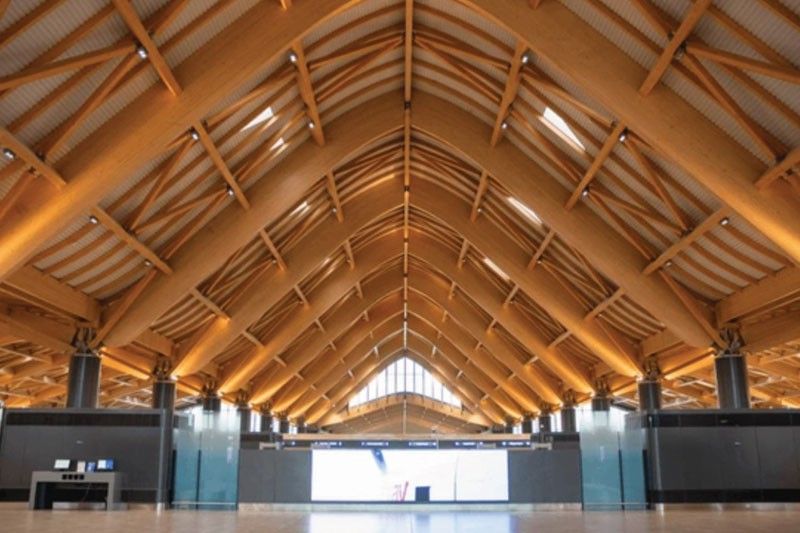In a multi-airport set-up, how can Clark keep up?

MANILA, Philippines — Clark International Airport may be flying in turbulent skies as the gateway was underutilized by 75 percent last year and is nowhere near regaining pre-pandemic levels, with both domestic and international passenger traffic down by double digits.
Further, Clark is just two hours away from the Ninoy Aquino International Airport (NAIA), which will undergo a P170.6-billion upgrade under a consortium led by San Miguel Corp. (SMC).
Another gateway in Central Luzon is also out to challenge Clark. The New Manila International Airport (NMIA), also a project of SMC, will rise in Bulacan by 2029. It will cost P735.63 billion and is set to become the largest airport in the Philippines.
The bright spot for Clark is that the government has a P38.28 billion pipeline to improve access to the airport and build businesses around it. The operator of the Clark airport is also convincing airlines to mount new routes and add flight options in the gateway.
Apart from this, provinces surrounding the airport are turning into growth areas, with Pampanga, where Clark is situated, accounting for almost a fourth of the Central Luzon economy. Cities around Clark such as Angeles and Olongapo are also showing potential to become metropolitan giants.
Still, the question bears asking: Are these developments enough to keep Clark competitive once NAIA is upgraded and NMIA is completed?
More flights needed
Primarily, Clark is intended as the jumpoff point to local and foreign destinations of people from Central Luzon, a region that stretches for more than 22,000 kilometers and has a population of at least 12.4 million.
However, Luzon International Premiere Airport Development (LIPAD) Corp., the operator of the gateway, views the Ilocos Region, Cagayan Valley and the Cordillera Administrative Region, as well as the north of Metro Manila, as part of its catchment.
In turn, the airport can cover as many as 23 million people in Luzon. Clark’s passenger terminal, which was completed in 2022, can welcome a maximum of eight million travelers annually.
However, Clark facilitated the travel of only two million passengers in 2023, behind by 75 percent from the design capacity of the airport. For 2024, LIPAD expects passenger traffic to hit 2.5 million on sustained demand for air travel and fresh routes added to the gateway.
LIPAD president and CEO Noel Manankil said the dream for Clark is to reach its full potential of serving eight million passengers every year.
So what is holding down Clark from ascending to cruising altitude?
In a column piece for The STAR published on April 5, opinion writer Boo Chanco lamented the lack of flight availability in Clark, making its aviation traffic pale in comparison to NAIA’s.
This view is shared by Cebu Pacific president and chief commercial officer Alexander Lao, who believes that passenger traffic in Clark would boom if the airport can expand its flight reach and frequency. The Gokongwei-owned airline already manages the largest network in Clark.
To date, Clark hosts 17 airlines on its runway: 12 flying to international cities, five connecting to domestic routes. The farthest that can be traveled from Clark is the Middle East, with daily trips to Doha courtesy of Qatar Airways and weekly flights to Dubai operated by Emirates.
Locally, Philippine Airlines (PAL), Cebu Pacific and AirAsia Philippines are keen on expanding their flight networks in Clark.
Cebu Pacific, for instance, is resuming its Clark flights to Davao, General Santos City, Iloilo and Puerto Princesa in October, helping the gateway open up the domestic market.
“Clark continues to be important for Cebu Pacific, and we believe our operations there will serve both north and central Luzon. We recently announced the resumption of four domestic routes out of Clark. We will continue to look at how to further expand operations, while balancing the need for growth in other parts of the Philippines,” Lao told The STAR.
PAL president and chief operating officer Stanley Ng shared his airline’s desire to introduce new connections from Clark. Recently, PAL transferred to Clark one of its niche services, flights to Basco, making the gateway the launch pad for Batanes trips.
“We are exploring possible expansion plans out of Clark, and this remains under study. On top of our four times weekly Clark-Basco service, we operate flights from Clark to Cebu, Busuanga and Caticlan,” Ng told The STAR.
AirAsia Philippines connects Clark and Caticlan on a daily frequency, but prior to the pandemic the airline links the gateway to Cagayan de Oro, Cebu, Davao, Iloilo, Puerto Princesa, Tacloban, Incheon, Kaohsiung and Taipei.
Public transport options
AirAsia Philippines spokesman Steve Dailisan raised the urgency to improve the transport modes to Clark to raise its commercial viability, an assessment shared by Manankil himself and an issue that LIPAD is trying to address.
“Meanwhile, an improvement in multimodal transportation can also significantly address Clark’s capacity as a preferred gateway for both local and foreign tourists,” Dailisan told The STAR.
“True, public transport is a challenge. We are actively engaging transport operators in the region, including the point-to-point buses, chartered transport, taxi companies and app-based transport,” Manankil said.
Clark International Airport Corp. (CIAC), the developer of the Clark Civil Aviation Complex, is also pursuing a pipeline of seven projects, worth over P38 billion, to enhance Clark’s proposition as an aviation hub. CIAC aims to finish these projects within the decade.
The largest in the CIAC’s multibillion peso blueprint is the P21-billion Clark Entertainment and Events Center, designed to host large-scale concerts and gatherings and increase visitor arrivals in Clark to the benefit of its airport.
On mobility, CIAC will embark on a P1.2-billion push to construct the Clark Direct Access Link, a 2.7 kilometer road bridging the airport to the North Luzon Expressway and Subic-Clark-Tarlac Expressway.
Moreover, CIAC president and CEO Arrey Perez told The STAR that his agency is working with transport providers in nearby towns to bring public utility vehicles to Clark.
“At present, talks about resuming point-to-point services to and from Clark and Dau are ongoing, apart from our negotiations with bus lines to ply these routes and augment the current offering of Genesis and Victory Liner. We also recognize and are actively working to establish local bus and e-jeepney routes from CAMANAVA, Bulacan and Pampanga,” Perez said.
However, the biggest transport infrastructure that could help Clark is the North-South Commuter Railway (NSCR), an P873.62-billion project that will span roughly 147 kilometers between New Clark City and Calamba, Laguna. The NSCR will host a commuter line and an airport express.
In 2023, the Department of Transportation awarded to Mitsubishi Corp. the P9-billion contract to supply the rolling stock to be deployed for the airport express of the NSCR.
The NSCR’s airport service will connect the Clark and Manila airports on a single track, cutting the travel time from point to point to below an hour.
“An important part of this transport system [NSCR] is the airport express, which will shorten the travel time from Makati City to Clark to less than an hour, and is expected to be a game changer for accessibility and ease of transport within the region,” Manankil said.

A decade to improve
For Manankil and Perez, considered as two of the big bosses in Clark, the airport will survive the upgrade of NAIA and development of NMIA. They believe that the joint efforts of the public and private sectors will make Clark stand out against its neighboring gateways in Mega Manila.
The incoming operator of NAIA will get a minimum of 15 years to overhaul what is considered as one of the worst airports in the world. Similarly, the first phase of NMIA is scheduled to open no later than 2029.
If at all, Clark has until the next decade to prove its worth as a viable gateway, so whether it will make it through turbulent skies is up to the people deciding its flight path.
Clark continues to be important for Cebu Pacific, and we believe our operations there will serve both north and central Luzon. We recently announced the resumption of four domestic routes out of Clark. We will continue to look at how to further expand operations, while balancing the need for growth in other parts of the Philippines.”
- Latest
- Trending


























